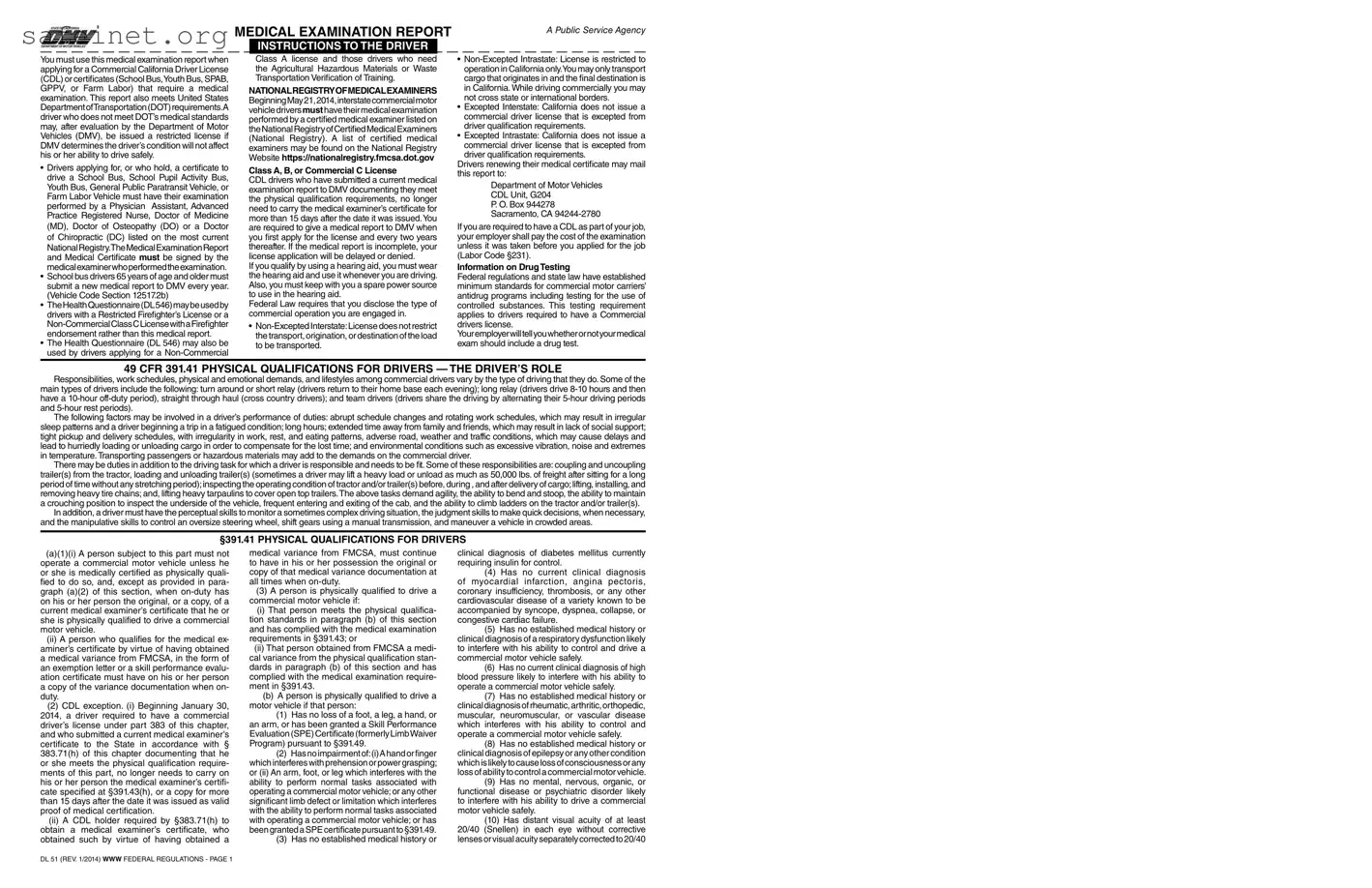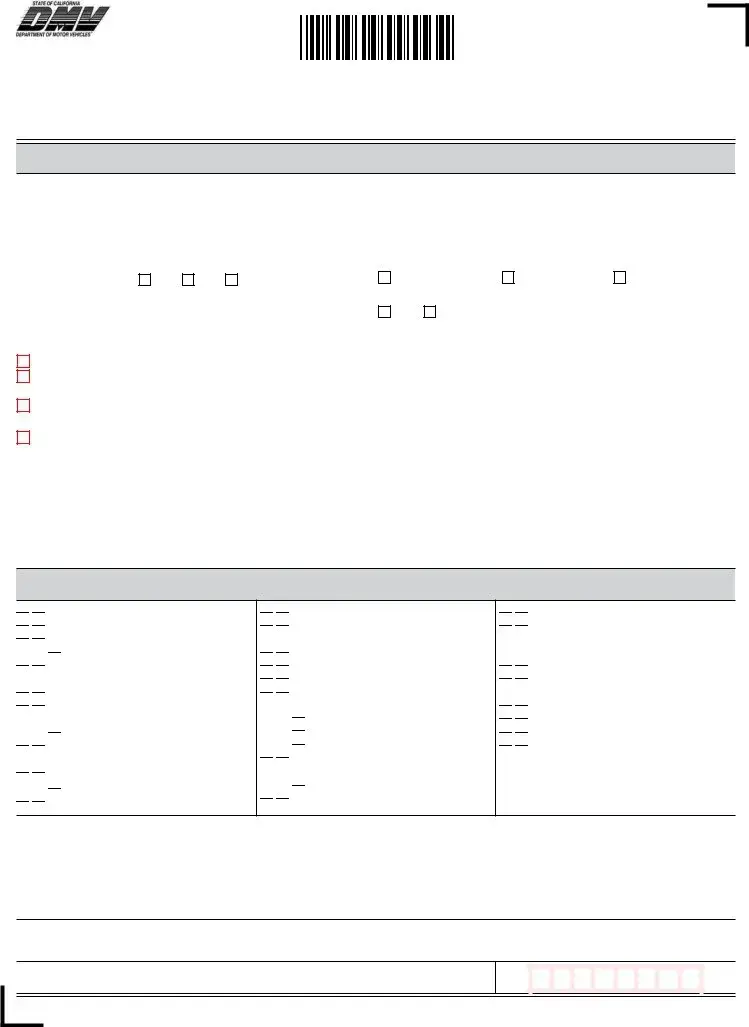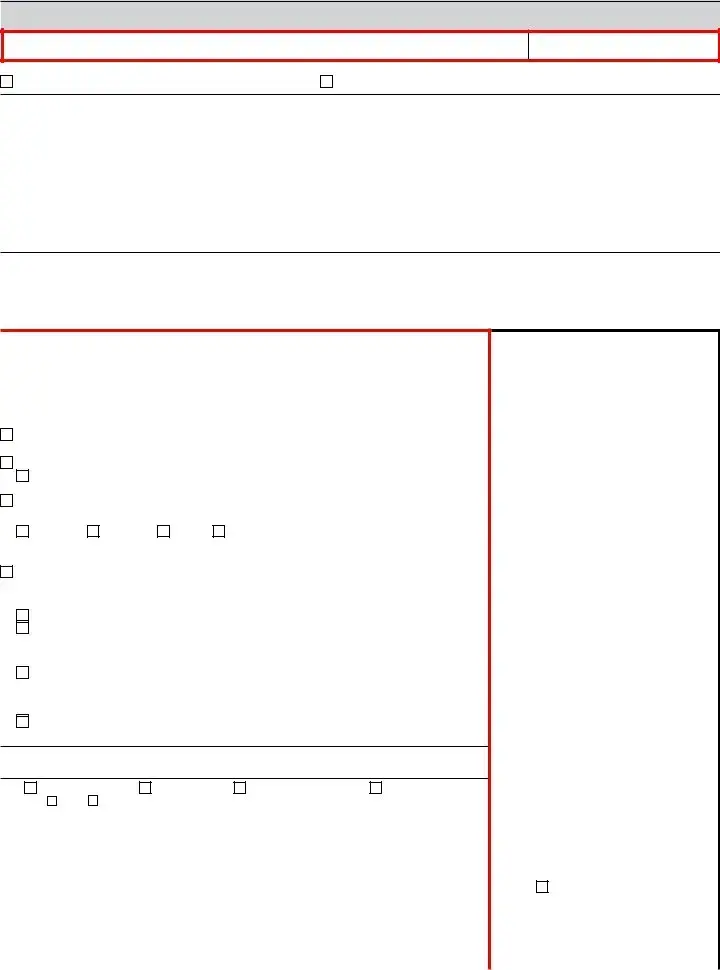Cardiovascular Condition: §391.41(b)(4)
A person is physically qualified to drive a commercial motor vehicle if that person:
Has no current clinical diagnosis of myocardial infarction,angina pectoris,coronary insufficiency, thrombosis or any other cardiovascular disease of a variety known to be accompanied by syncope, dyspnea, collapse or congestive cardiac failure.
The term “has no current clinical diagnosis of” is speciically designed to encompass: “a clinical diagnosis of” (1) a current cardiovascular condition, or (2) a cardiovascular condition which has not fully stabilized regardless of the time limit. The term “known to be accompanied by” is designed to include: a clinical diagnosis of a cardiovascular disease (1) which is accompanied by symptoms of syncope, dyspnea, collapse or congestive cardiac failure; and/or (2) which is likely to cause syncope, dyspnea, collapse or congestive cardiac failure.
It is the intent of the FMCSRs to render unqualified, a driver who has a current cardiovascular disease which is accompanied by and/or likely to cause symptoms of syncope, dyspnea, collapse, or congestive cardiac failure. However, the subjective decision of whether the nature and severity of an individual’s condition will likely cause symptoms of cardiovascular insufficiency is on an individual basis and qualiication rests with the medical examiner and the motor carrier. In those cases where there is an occurrence of cardiovascular insufficiency (myocardial infarction, thrombosis, etc), it is suggested before a driver is certiied that he or she have a normal resting and stress electrocardiogram (ECG), no residual complications and no physical limitations, and is taking no medication likely to interfere with safe driving.
Coronary artery bypass surgery and pacemaker implantation are remedial procedures and thus, not unqualifying.Implantable cardioverter defibrillators are disqualifying due to risk of syncope. Coumadin is a medical treatment which can improve the health and safety of the driver and should not, by its use, medically disqualify the commercial driver.The emphasis should be on the underlying medical conditions(s) which require treatment and the general health of the driver. The FMCSA should be contacted at (202) 366- 4001 for additional recommendations regarding the physical qualiication of drivers on coumadin. (See Cardiovascular Advisory Guidelines for the Medical Examination of Commercial Motor Vehicle Drivers at: www.fmcsa.dot.gov/rulesregs/medreports. htm)
Respiratory Dysfunction §391.41(b)(5)
A person is physically qualified to drive a commercial motor vehicle if that person:
Has no established medical history or clinical diagnosis of a respiratory dysfunction likely to interfere with ability to control and drive a commercial motor vehicle safely.
Since a driver must be alert at all times, any change in his or her mental state is in direct conflict with highway safety. Even the slightest impairment in respiratory function under emergency conditions (when greater oxygen supply is necessary for performance) may be detrimental to safe driving.
There are many conditions that interfere with oxygen exchange and may result in incapacitation, including emphysema, chronic asthma, carcinoma, tuberculosis, chronic bronchitis and sleep apnea. If the medical examiner detects a respiratory dysfunction, that in any way is likely to interfere with the driver’s ability to safely control and drive a commercial motor vehicle, the driver must be referred to a specialist for further evaluation and therapy. Anticoagulation therapy for deep vein thrombosis and/or pulmonary thromboembolism is not unqualifying once optimum dose is achieved, provided lower extremity venous examinations remain normal and the treating physician gives a favorable recommendation. (See Conference on Pulmonary/Respiratory Disorders
DL 51 (REV. 1/2014) WWW FEDERAL REGULATIONS - PAGE 3
and Commercial Drivers at: www.fmcsa.dot.gov/rulesregs/medreports. htm)
hypertension §391.41(b)(6)
A person is physically qualified to drive a commercial motor vehicle if that person:
Has no current clinical diagnosis of high blood pressure likely to interfere with the ability to operate a commercial motor vehicle safely.
Hypertension alone is unlikely to cause sudden collapse; however, the likelihood increases when target organ damage, particularly cerebral vascular disease, is present. This regulatory criteria is based on FMCSA’s Cardiovascular Advisory Guidelines for the Examination of CMV Drivers, which used the Sixth Report of the Joint National Committee on Detection, Evaluation, and Treatment of High Blood Pressure (1997).
Stage 1 hypertension corresponds to a systolic BP of 140-159 mmHg and/or a diastolic BP of 90-99 mmHg. The driver with a BP in this range is at low risk for hypertension-related acute incapacitation and may be medically certiied to drive for a one-year period. Certification examination should be done annually thereafter and should be at or less than 140/90. If less than 160/100, certiication may be extended one time for 3 months.
Ablood pressure of 160-179 systolic and/ or 100-109 diastolic is considered Stage 2 hypertension, and the driver is not necessarily unqualified during evaluation and institution of treatment. The driver is given a one time certiication of three months to reduce his or her blood pressure to less than or equal to 140/90.
A blood pressure in this range is an absolute indication for anti-hypertensive drug therapy. Provided treatment is well tolerated and the driver demonstrates a BP value of 140/90 or less, he or she may be certiied for one year from date of the initial exam. The driver is certiied annually thereafter.
A blood pressure at or greater than 180 (systolic) and 110 (diastolic) is considered Stage 3, high risk for an acute BP-related event. The driver may be not qualiied, even temporarily, until reduced to 140/90 or less and treatment is well tolerated.The driver may be certiied for 6 months and biannually (every 6 months) thereafter if at recheck BP is 140/90 or less.
Annual recertiication is recommended if the medical examiner does not know the severity of hypertension prior to treatment.
An elevated blood pressure inding should be confirmed by at least two subsequent measurements on different days.
Treatment includes nonpharmacologic and pharmacologic modalities as well as counseling to reduce other risk factors. Most antihypertensive medications also have side effects, the importance of which must be judged on an individual basis. Individuals must be alerted to the hazards of these medications while driving. Side effects of somnolence or syncope are particularly undesirable in commercial drivers.
Secondary hypertension is based on the above stages. Evaluation is warranted if patient is persistently hypertensive on maximal or near- maximual doses of 2-3 pharmacologic agents. Some causes of secondary hypertension may be amenable to surgical intervention or speciic pharmacologic treatment.
(See Cardiovascular Advisory Panel Guidelines for the Medical Examination of Commercial Motor Vehicle Drivers at: www.fmcsa.dot.gov/rulesregs/medreports. htm)
Rheumatic, arthritic, orthopedic, Muscular, neuromuscular or vascular Disease §391.41(b)(7)
A person is physically qualified to drive a commercial motor vehicle if that person:
Has no established medical history or clinical diagnosis of rheumatic, arthritic, orthopedic, muscular, neuromuscular or vascular disease
which interferes with the ability to control and operate a commercial motor vehicle safely.
Certain diseases are known to have acute episodes of transient muscle weakness, poor muscular coordination (ataxia), abnormal sensations (paresthesia), decreased muscular tone (hypotonia), visual disturbances and pain which may be suddenly incapacitating. With each recurring episode, these symptoms may become more pronounced and remain for longer periods of time. Other diseases have more insidious onsets and display symptoms of muscle wasting (atrophy), swelling and paresthesia which may not suddenly incapacitate a person but may restrict his/her movements and eventually interfere with the ability to safely operate a motor vehicle. In many instances these diseases are degenerative in nature or may result in deterioration of the involved area.
Once the individual has been diagnosed as having a rheumatic, arthritic, orthopedic, muscular, neuromuscular or vascular disease, then he/she has an established history of that disease. The physician, when examining an individual should consider the following: (1) the nature and severity of the individual’s condition (such as sensory loss or loss of strength); (2) the degree of limitation present (such as range of motion); (3) the likelihood of progressive limitation (not always present initially but may manifest itself over time); and (4) the likelihood of sudden incapacitation. If severe functional impairment exists, the driver does not qualify. In cases where more frequent monitoring is required, a certiicate for a shorter period of time may be issued.
(See Conference on Neurological Disorders and Commercial Drivers at: www.fmcsa.dot.gov/rulesregs/medreports. htm)
epilepsy §391.41(b)(8)
A person is physically qualified to drive a commercial motor vehicle if that person:
Has no established medical history or clinical diagnosis of epilepsy or any other condition which is likely to cause loss of consciousness or any loss of ability to control a motor vehicle.
Epilepsy is a chronic functional disease characterized by seizures or episodes that occur without warning, resulting in loss of voluntary control which may lead to loss of consciousness and/or seizures. Therefore, the following drivers cannot be qualiied: (1) a driver who has a medical history of epilepsy; (2) a driver who has a current clinical diagnosis of epilepsy; or (3) a driver who is taking antiseizure medication.
If an individual has had a sudden episode of a nonepileptic seizure or loss of consciousness of unknown cause which did not require antiseizure medication, the decision as to whether that person’s condition will likely cause loss of consciousness or loss of ability to control a motor vehicle is made on an individual basis by the medical examiner in consultation with the treating physician. Before certiication is considered, it is suggested that a 6-month waiting period elapse from the time of the episode. Following the waiting period, it is suggested that the individual have a complete neurological examination. If the results of the examination are negative and antiseizure medication is not required, then the driver may be qualiied.
In those individual cases where a driver has a seizure or an episode of loss of consciousness that resulted from a known medical condition (e.g., drug reaction, high temperature, acute infectious disease, dehydration or acute metabolic disturbance), certification should be deferred until the driver has fully recovered from that condition and has no existing residual complications, and is not taking antiseizure medication. Drivers with a history of epilepsy/ seizures off antiseizure medication and seizure- free for 10 years may be qualiied to drive a CMV in interstate commerce. Interstate drivers with a history of a single unprovoked seizure may be qualiied to drive a CMV in interstate commerce







 Any illness or injury in last 5 years
Any illness or injury in last 5 years


 Head/Brain injuries, disorders or illnesses
Head/Brain injuries, disorders or illnesses


 Seizures, epilepsy
Seizures, epilepsy
 medication ____________________
medication ____________________


 Eye disorders or impaired vision (except corrective lenses)
Eye disorders or impaired vision (except corrective lenses)


 Ear disorders, loss of hearing or balance
Ear disorders, loss of hearing or balance


 Heart disease or heart attack, other cardiovascular condition
Heart disease or heart attack, other cardiovascular condition
 medication ____________________
medication ____________________

 Heart surgery (valve replacement/ bypass, angioplasty, pacemaker)
Heart surgery (valve replacement/ bypass, angioplasty, pacemaker) 

 High blood pressure
High blood pressure
 medication ____________________
medication ____________________


 Muscular disease
Muscular disease


 Shortness of breath
Shortness of breath


 Lung disease, emphysema, asthma, chronic bronchitis
Lung disease, emphysema, asthma, chronic bronchitis


 Kidney disease, dialysis
Kidney disease, dialysis


 Liver disease
Liver disease


 Digestive problems
Digestive problems


 Diabetes or elevated blood sugar controlled by:
Diabetes or elevated blood sugar controlled by:
 diet
diet
 pills
pills
 insulin
insulin


 Nervous or psychiatric disorders, e.g., severe depression
Nervous or psychiatric disorders, e.g., severe depression
 medication ____________________
medication ____________________


 Loss of, or altered consciousness
Loss of, or altered consciousness


 Fainting, dizziness
Fainting, dizziness


 Sleep disorders, pauses in breathing while asleep, daytime sleepiness, loud snoring
Sleep disorders, pauses in breathing while asleep, daytime sleepiness, loud snoring


 Stroke or paralysis
Stroke or paralysis


 Missing or impaired hand, arm, foot, leg, inger, toe
Missing or impaired hand, arm, foot, leg, inger, toe


 Spinal injury or disease
Spinal injury or disease


 Chronic low back pain
Chronic low back pain

 Regular, frequent alcohol use
Regular, frequent alcohol use 

 Narcotic or habit forming drug use
Narcotic or habit forming drug use

